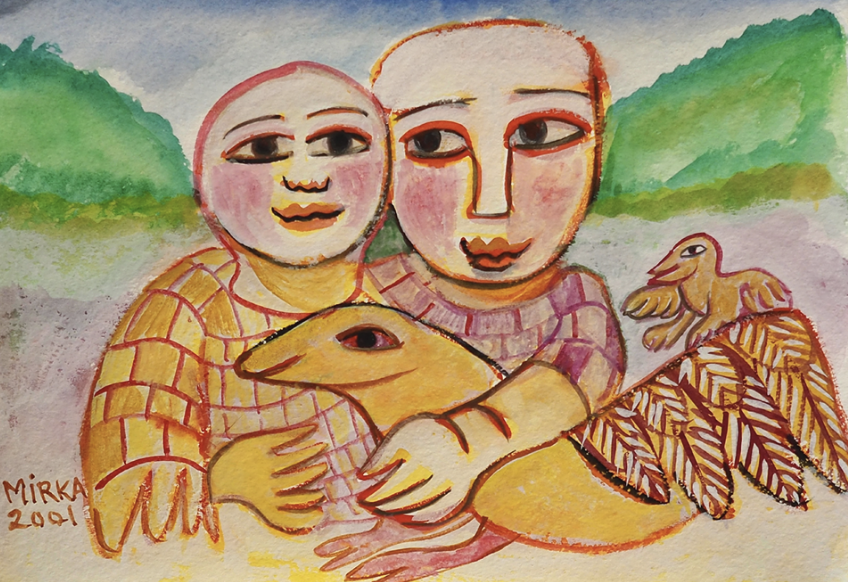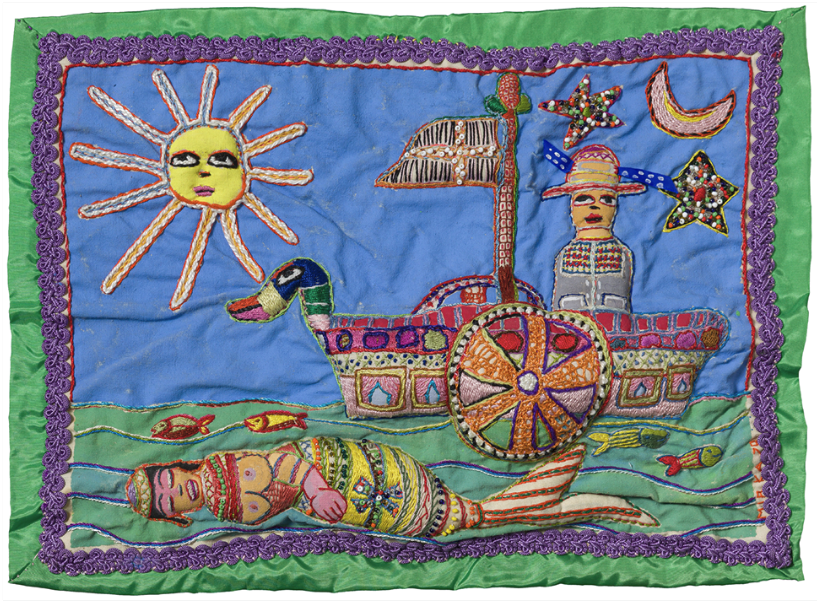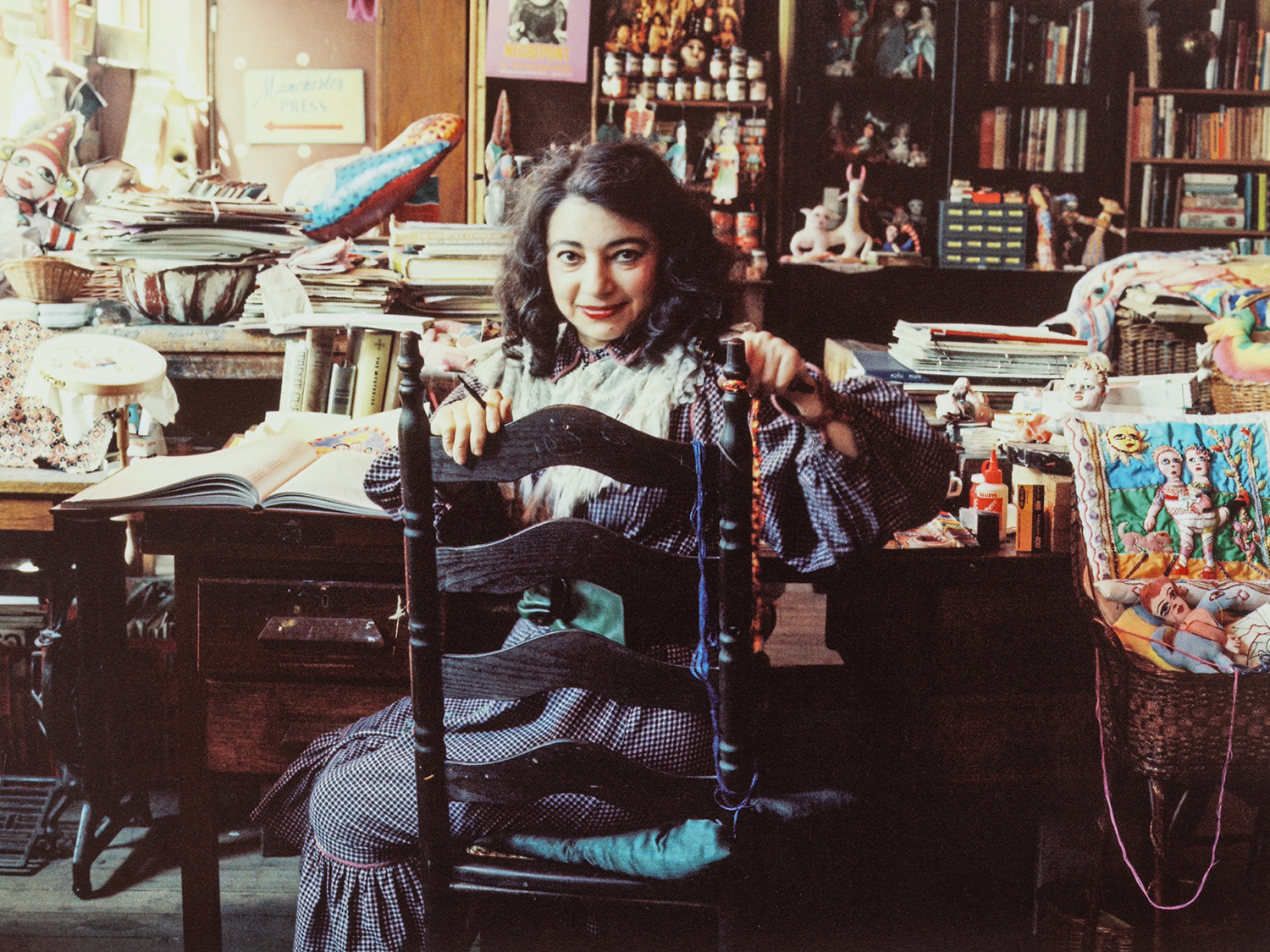Amanda North, Senior Fine Art Specialist, speaks with Anna Mortley, director of William Mora Galleries and manager of the Mirka Mora Estate.
For those that do not already know, tell us about your connection to Mirka Mora and William Mora Galleries.
I grew up in Paris. When I arrived in Melbourne, I met Mirka and spent time with her during the last decade of her life. She was my mother-in-law. Having a background in visual and performing arts, William (Mora) and I shared a strong connection in art which eventuated in us working together in the gallery quite early on in our relationship. In 2018, when Mirka passed away, we started the process of organising her Estate. For 9 months, I photographed and catalogued her works. We kept on finding hidden treasures -mostly works on paper in books, boxes, shelves… I will never forget this. It was both magical and daunting!

In the Valley of Love 2001
gouache on paper. © The Estate of Mirka Mora. Courtesy William Mora Galleries
Mirka Mora’s style is instantly recognisable – whimsical, symbolic, and deeply personal. How did she develop her visual language over the decades?
I would say that even though Mirka had found the essence of her style in the mid-sixties, she never stopped exploring an infinity of variations and that the more joyful and playful component in her style came in the early seventies. As a true artist, she never ceased to expand the possibilities, pushing the boundaries—whether it was in painting itself, doll-making, embroidery, or drawing. Mirka was always reading and collecting information on other artists or on any matter that caught her fascination. She painted until the very end of her life. Her last canvases were completed in 2016. They were of a smaller size than usual (46 x 37 cm). William and I had noticed that her larger canvases were left to the side, so we thought she might like to try smaller ones. She painted a series of 17 works and then became very ill and couldn’t continue doing so.
Mirka worked across different media, some of which will be highlighted in Leonard Joel’s upcoming Women Artist Auction. Was she drawn to one medium more than others?
Mirka mastered many techniques. She allowed herself to break the rules. She would say, “I never follow the recipes.” In the Women Artists auction, you can see a selection of works on paper, canvas, soft sculptures, an embroidery, and some rare ceramics. She always had several things on the go.
Mirka’s textile works were made in the seventies and early eighties. As you will notice in this embroidery, the amount of work is incredibly detailed. Ports and Harbours is made of embroidery thread, beads, synthetic polymer paint on cotton and synthetic textile backing – a real testimony to Mirka’s devotion to her works. This embroidery is an ode to her beloved St Kilda beach; she describes the stars as “precious stones”.
Ultimately, I would say that Mirka was essentially a painter at heart, and every other medium she used really was to prepare for paintings or an extension of that. She fully committed to oil painting in her thirties. However, after her separation with Georges Mora in 1970, she claimed she was too sad to paint, so she started making dolls. “As a rule, I do not paint when I’m distressed, I like to have a clear mind.”
Mirka could easily go from one medium to another. You can see the thinking process in each piece. She drew all her life, and also wrote, leaving many journals. She just had this need to keep creating or “working” as she would have said.
Her use of recurring symbols such as angels, birds and children is so distinctive. Can you speak to the personal or cultural significance of these motifs?
Mirka used symbols and references to Greek mythology to create an infinity of scenes in which they all had different meanings and purposes. For example, the horns of the devils show strength and stability, whilst the angels are more worrying because they are fleeting—so sometimes she would draw an angel with only one wing to make sure it would stay.
Do you have a favourite artwork in the selection of works we are auctioning in the Women Artists sale?
I am very drawn to In the Valley of Love (2001), because of the colours and that sense of space that is created by the two green hills. There is something gentle and almost dreamlike about the way the faces hold the scene – a world you can escape into. This piece features a touch of landscape, which is rare. Mirka once said: “I’m preparing myself to paint a landscape in my very old age, and it will be my Australian testament.”

Ports and Harbours 1978
embroidery thread, beads, synthetic polymer painton cotton and synthetic textile backing
© The Estate of Mirka Mora. Courtesy William Mora Galleries. Photo by Mark Ashkanasy
Mirka was deeply connected to the Australian art community. Are there particular collaborations or friendships with other artists that stand out?
Mirka’s most meaningful connections with artists in Melbourne were probably made shortly after arriving in Australia within the Heide circle – John and Sunday Reed, Joy Hester, Albert Tucker, Charles and Barbara Blackman, only to name a few. These encounters propelled her onto the path of a career she was about to have. At all times, Mirka was in contact with artists from here or abroad, at the heart of the arts community, drawn to exchanges and interested in any form of expression. She was very generous with her time. Often, artists come to the gallery and say how Mirka encouraged them to follow their path.
The Estate of Mirka Mora has done an incredible job in preserving and sharing Mirka’s legacy. What does that work look like behind the scenes—from conservation to curation?
The work in the Estate is continuous, ongoing, and on all fronts at the same time. Mirka was prolific, to say the least, and a very hard worker. She has left behind many sketchbooks, notes, letters… The size of the collection requires constant attention.
I feel very fortunate to be working with Eleni Papavasileio – who curated the 2021 Mirka survey at the Jewish Museum of Australia – bringing her expertise to the Estate as we catalogue the archive and rehouse the works on paper. The tasks range from identifying what needs to be repaired so that we can attend to that, to creating a filing system that enables us to have fast access to the data to facilitate the curation or loans. We aim for the rehousing to take place using acid free and inert archival grade materials.
A couple of times a year, I select a group of works on paper and take them to the framers. The works are mounted and framed. This creates a robust layer of protection against external agents of deterioration such as dust and unnecessary handling, while allowing the works to exist in a microclimate, thus aiding their longer-term preservation.
What have become the most important aspects in managing the Estate and preserving Mirka’s art and legacy?
The most important aspects in managing Mirka’s Estate are ensuring that her art is well documented, kept in a safe environment, and accessible to the general public through regular exhibitions and partnerships with public institutions. It’s also vital to preserve the spirit of Mirka’s practice – her curiosity, and unwavering dedication to making – so that future generations can engage with her work in a meaningful way.
What are the priorities of the Estate in terms of conserving, cataloguing, and sharing Mirka’s work with the public?
The priorities are that Mirka’s work is seen as much as possible. The love and fascination people have for both her persona and her art is so great that I feel we owe it to her. William used to say, “Everybody owns Mirka.” It is essential that the integrity of her works remains and is understood—that it is not diluted over the years.
As custodians of her legacy, what has surprised you most in revisiting Mirka’s archive—be it diaries, sketchbooks, or lesser-known works?
I must admit that Mirka’s works never cease to surprise. I have been very taken aback by the volume of sketchbooks and journals that she left behind. I also admire the range of media she experimented with.
When I was doing the photography for the Estate, I became mesmerised by her charcoals and pastels. I had never really seen anything like that. The contrast between softness and strength, -especially when shifting between sharp detail and atmospheric blur- can be incredibly evocative. I think that creates emotion because it draws you in. I am, also, constantly in disbelief when looking at the confidence in her line.
Mirka’s work continues to resonate with contemporary audiences. Why do you think her imagery and ethos remain so beloved today?
I think Mirka’s imagery is universal, and that is why it still resonates with artists today. It is also timeless and is about everyone at any one time.
Finally, if there is one thing you would like people to take away from Mirka’s life and work today, what would it be?
I love the certainty in her work. Every piece shows how she embraced life – a combination of tenderness and fierce strength. I hope people are reminded that creativity can be both a form of resilience and a celebration of being alive.
With thanks to Anna Mortley for her time.
Our Women Artists Auction will take place on Monday 22 September at 6pm in Melbourne. For viewing times and to see the full catalogue please visit our website.
By Amanda North, Senior Fine Art Specialist
Top Image: Mirka Mora on chair smiling, Rankins Lane, Naarm, Melbourne, 1977. Photo by Stella Sallman
August 2025
